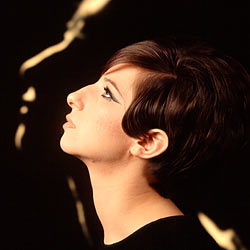
Max Gordon, late owner of the Village Vanguard, liked to tell the possibly exaggerated story of the “little pisher” who hung around the club in 1961, pestering him for a chance to perform. He flicked her away for weeks, but when his headliner, Miles Davis, was later than usual for a gig one night, he finally gave the Brooklyn teen permission to audition a few songs.
It’s unclear whether Barbra Streisand had, by that point, amputated the superfluous “a” from her first name, but she’d not shied from cutting a style for herself in every other area. YouTube is full of astonishing clips of her in those years, gawky and expressionistic, wearing “interesting” clothes and seething with the I’ll-show-you ambition of a girl who’d made it that far, as her website puts it even now, “unassisted and without encouragement.” (Thanks, Mom!) She would have seemed a misfit: certainly no jazz chanteuse, soigné and parsimonious with her notes. Rather, she was a belter, a big mess of personality, a cross-eyed character in a Dr. Seuss parable, alchemizing frustration into gold mines of sound. Within a year, she was a star.
If she was in a rush, the young Streisand seemed to sense that a deadline in the culture was fast approaching. The songs she was singing—“Cry Me a River,” “A Sleepin’ Bee,” “Happy Days Are Here Again”—were already passé among her contemporaries. Though she would later dabble in any genre that sold records, including Christmas carols, she seemed faintly ludicrous slumming as a disco diva, or going down the stoney end. (Did no one dare question the logic of her crooning about being raised on the good book Jesus by a mother who worked in the mines?) At her best, she was a creature of high if idiosyncratic standards, responding innately to the songs that we now call, without much irony, by that name.
To her credit, the 67-year-old who will finally return to the Vanguard this Saturday is once again championing her natural repertoire in its natural habitat. For Love Is the Answer, the album the concert is meant to promote, she has chosen thirteen songs whose average year of composition is 1963. Actually, she sings each song twice: on one CD backed by Diana Krall and her jazz quartet, on the other immersed in a full orchestral soup concocted by arranger Johnny Mandel. The soup is, shall we say, rich. The boîte-style versions give a better taste of the deprivation that made Barbara “Barbra.”
The great pop singers of the Golden Era delivered an emotional wallop powered either by the compression of anger or the sublimation of despair. Usually men were in the first category and women in the second—Sinatra and Garland, archetypally. Streisand defied the pattern. Her subtext has always been the fury of the kooky, odd-looking girl getting revenge by asserting her own kind of femininity—and trying to move the culture toward her instead of the other way around.
She succeeded, amazingly, but by the seventies the magnetism of the new was too unyielding even for this most willful of singers. To continue to have a major career (and to finance her other ambitions), she threw herself into the mainstream, one by one smoothing out all her misfit attributes until she seemed almost homogenized: like buttah. Even her singing got too gorgeous sometimes, with its hypnotic nasality and hilariously personal consonants. Which is why it’s nice to hear Streisand recovering her standards. These are songs that dare to talk back, that risk her wrath. As a singer, anyway, she usually wins a fair fight.
Have good intel? Send tips to intel@nymag.com.